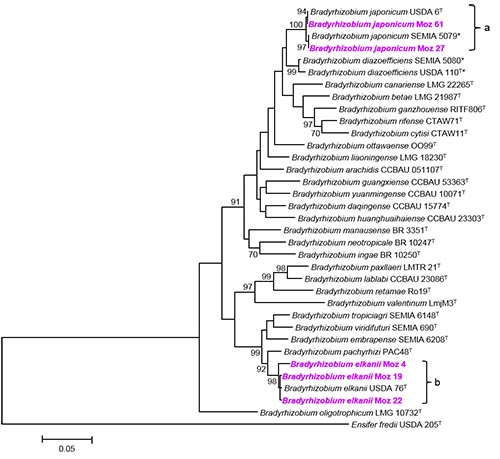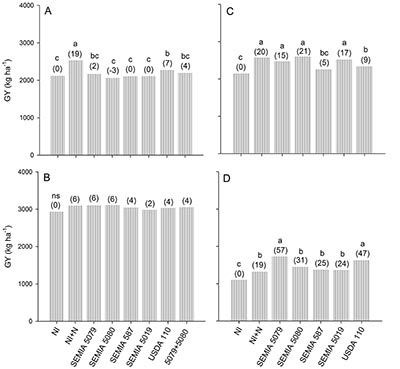Amaral Machaculeha Chibeba, from Mozambique, was awarded a PhD fellowship by the Wageningen University in 2012 under the N2Africa Project. The four-year studies were conducted under the supervision of Dr. Maria de Fátima Guimarães from Londrina State University (Brazil), Dr. Mariangela Hungria from Embrapa (Brazil) and Dr. Stephen Kyei-Boahen from IITA (Mozambique) between June 2012 and September 2016. During the last 12 months the awardee worked on revising two articles of his already defended PhD Thesis. Both articles have just been published with open access by Agriculture, Ecosystems & Environment.
Chibeba A.M., Kyei-Boahen, S., de Fátima Guimarães, M., Nogueira, M.A., Hungria, M., 2017. Isolation, characterization and selection of indigenous Bradyrhizobium strains with outstanding symbiotic performance to increase soyabean yields in Mozambique. Agriculture, Ecosystems & Environment, 246, 291–305.
In this article, 105 isolates obtained from nodules of promiscuous soyabean grown at 15 sites in Manica (4), Nampula (2), Tete (6) and Zambézia (3) provinces, in Mozambique, were screened for N2-fixation effectiveness in the greenhouse in Brazil along with five commercial strains. Eighty-seven isolates confirmed the ability to form effective nodules on soyabean and were used for genetic characterization by rep-PCR (BOX) and sequencing of the 16S rRNA gene, and also for symbiotic effectiveness. BOX-PCR fingerprinting revealed remarkable genetic diversity, with 41 clusters formed, considering a similarity level of 65%. The 16S rRNA analysis assigned the isolates to the genera Bradyrhizobium (75%) and Agrobacterium/Rhizobium (25%). Great variability in symbiotic effectiveness was detected among the indigenous rhizobia from Mozambique, with ten isolates performing better than the commercial strain B. diazoefficiens USDA 110, the best reference strain, and 51 isolates with lower performance than all reference strains. Five isolates, three (Moz 4, Moz 19 and Moz 22) belonging to the superclade B. elkanii and two (Moz 27 and Moz 61) assigned to the superclade B. japonicum, consistently showed high symbiotic effectiveness, suggesting that the inoculation with indigenous rhizobia adapted to local conditions represents a possible strategy for increasing soyabean yields in Mozambique. Phylogenetic position of the five elite isolates was confirmed by the MLSA with four protein-coding housekeeping genes, dnaK, glnII, gyrB and recA (Figure 1).

|
Chibeba A.M., Kyei-Boahen, S., de Fátima Guimarães, M., Nogueira, M.A., Hungria, M., 2017. Feasibility of transference of inoculation-related technologies: A case study of evaluation of soyabean rhizobial strains under the agro-climatic conditions of Brazil and Mozambique. Agriculture, Ecosystems & Environment, online 14 July 2017, In Press, Corrected Proof
| Here, the performance of five strains (four Brazilian and one North American) in the 2013/2014 and 2014/2015 crop seasons in Brazil and Mozambique was evaluated. The experimental areas were located in relatively similar agro-climatic regions and had soyabean nodulating rhizobial population ranging from <<10 to 2 ×105 cells g−1 soil. The treatments were: (1) NI, non-inoculated control with no N-fertilizer; (2) NI + N, non-inoculated control with 200 kg of N ha−1; and inoculated with (3) Bradyrhizobium japonicum SEMIA 5079; (4) B. diazoefficiens SEMIA 5080; (5) B. elkanii SEMIA 587; (6) B. elkanii SEMIA 5019; (7) B. diazoefficiens USDA 110; (8) SEMIA 5079 + 5080. The best inoculation strains across locations and crop seasons in Brazil and Mozambique were SEMIA 5079, SEMIA 5080 and USDA 110 (Figure 2) suggesting that the transference of inoculation technologies between countries is feasible. |

SEMIA 587, B. elkanii SEMIA 587; SEMIA 5019, B. elkanii SEMIA 5019; USDA 110, B. diazoefficiens USDA 110; 5079+5080, B. japonicum SEMIA 5079 and B. diazoefficiens SEMIA 5080. Bars are means of six (Brazil) or five (Mozambique) replicates and when followed by same letter in the same country and crop season are not statistically different (p ≤ 0.10, Duncan); ns signifies no statistical differences were detected (p ≤ 0.10, Duncan); numbers in parentheses represent percentage increases in relation to the NI treatment (Source: Chibeba, et al. 2017). |
Dr. Chibeba is presently working for IITA – Mozambique, since January 2017, as Postdoctoral Fellow in Agronomy and Soil Microbiology. His main responsibility is to conduct multi-location field trials with the promising indigenous rhizobial isolates identified in Brazil (first trial above) to confirm their potential use in inoculants for soyabean in Mozambique.
Amaral Chibeba, State University of Londrina (UEL), Brazil (Click here for his 2016 update)
